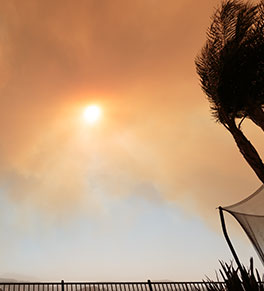Protect your lungs during fire season

“People with asthma and other respiratory conditions, especially older adults and children, should stay indoors in order to minimize exposure to poor air quality caused by the wildfires,” says UCI Health lung specialist Dr. Javier Longoria.
Every year between June and November, wildfires race across California. However, 2020 is already the worst season on record with more than three million acres incinerated and two months of fire season still remaining.
As these blazes spread across the state, they are causing hazardous levels of air pollution in many regions.
“People with asthma and other respiratory conditions, especially older adults and children, should stay indoors in order to minimize exposure to poor air quality caused by the wildfires,” says Dr. Javier Longoria, a UCI Health specialist in pulmonary and critical care medicine.
Apart from the damage these wildfires cause to life and property, their fumes contain vapors, gases and tiny airborne particles that can travel huge distances, affecting communities hundreds of miles and more from the wildfires, themselves.
“The particles generated by the burning of biomass materials from trees and scrubs contain metals (some toxic) and organic materials — many of which are irritating to the respiratory tract,” says Michael Kleinman, PhD, professor of occupational and environmental medicine at the UCI School of Medicine.
These particles may also cause damage to the lungs and possibly the heart, Kleinman says, adding "Some of the compounds are also known carcinogens.”
Dr. Richard A. Lee, director of the medical ICU and respiratory care services at UCI Medical Center, advises people to pay attention to their breathing.
“Watch out for symptoms such as wheezing, shortness of breath, difficulty taking a full breath, chest heaviness, lightheadedness and dizziness,” Lee says. “If your symptoms are not relieved by the usual medicines, contact your physician immediately. If you are experiencing respiratory distress, go to the nearest emergency room for evaluation or call 911.”
Safety tips
If you smell smoke or see ash due to a wildfire, the South Coast Air Quality Management District recommends the following to limit your exposure:
- Remain inside with windows and doors closed or seek alternate shelter.
- Avoid vigorous physical activity.
- Run an air conditioner if you have one. Make sure it has a clean filter and that it is set to recirculate the indoor air to prevent drawing smoke inside.
- Create a clean air space in your home by using a portable air cleaner in addition to, or instead of, the air conditioner. Use in one or more rooms with doors and windows closed.
- Avoid using a whole-house fan or a swamp cooler that would draw air into your home.
- Avoid using indoor or outdoor wood-burning appliances, including fireplaces.
- Avoid burning candles or incense.
If you must travel during smoky air conditions, keep pollutants our of your vehicle by closing windows and vents, and running the air conditioner in recirculate mode.
For more information on wildfire resources and to get air quality alerts, please visit SCAQMD ›
After a wildfire
Take precautions when cleaning your property of ash from wildfires. Ash has different health effects than smoke since its particles are usually larger than smoke particles.
To safely clean up ash, the California Department of Public Health recommends the following:
- Wear a close-fitting respirator that is rated N-95 or P-100 to prevent ash from being inhaled. Bandanas, surgical or cloth masks do not effectively block fine particles.
- Wear protective gloves, long-sleeved shirts, long pants, socks and shoes to avoid skin contact with ash.
- Never use a leaf blower, which will only spread the ash and blow it back into the air.
- Do not use shop or household vacuum cleaners unless they have HEPA filters to capture particles from blowing into the air where they may be inhaled.
- Remove shoes before entering your home or use a sticky mat in entryways and doors to remove dust and ash from your shoes. Sticky mats are sold at hardware stores.
- Gently sweep indoor and outdoor hard surfaces, followed by a wet mopping. Use a damp cloth on surfaces with light ash dust.
- If you do get ash on your skin, wash it off as soon as possible.
- Do not let children play in ash and wash off toys before children play with them.
- Keep pets out of ash areas. Either clean ash off pets with a damp cloth or give them a full bath.
Will a mask help?
Paper and cloth masks don't provide adequate protection from smoke, according to the U.S. Environmental Protection Agency (EPA). Dust masks made of paper can block large particles such as sawdust, but they do not protect your lungs from small particles or gases found in wildfire smoke.
The most effective way to protect yourself during wildfire emergencies is to stay indoors, follow the above steps and limit your time outdoors when there is smoke in the air.
People who must be outside for extended periods of time in smoky air or an ash-covered area may benefit from using a tight-fitting particulate respirator that has been tested and approved by the National Institute of Occupational Safety and Health (NIOSH).
It will have the words “NIOSH” and either “N95” or “P100” printed on it. However, these respirators are still in short supply due to the COVID-19 pandemic and should be reserved as much as possible for healthcare workers.
Learn more about using respirators and getting a proper fit ›




